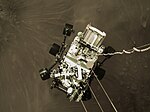astro.wikisort.org - Asteroid
3361 Orpheus (1982 HR) is an Apollo asteroid that was discovered on 24 April 1982 by Carlos Torres at Cerro El Roble Astronomical Station. Its eccentric orbit crosses that of Mars and Earth, and approaches Venus as well. From 1900 to 2100 it passes closer than 30 Gm to Venus 11, Earth 33, and Mars 14 times. It passed by Earth at a distance of about 0.03 AU (4.5 million km; 12 LD) in 1937, 1978, 1982, and 2021 and will again in 2025.[1]
| Discovery | |
|---|---|
| Discovered by | Carlos Torres |
| Discovery site | Cerro El Roble |
| Discovery date | 24 April 1982 |
| Designations | |
MPC designation | (3361) Orpheus |
| Pronunciation | /ˈɔːrfiːəs, ˈɔːrfjuːs/ |
Named after | Ὀρϕεύς Orpheus |
Alternative designations | 1982 HR |
Minor planet category | PHA[1] |
| Adjectives | Orphean (Orphæan) /ɔːrˈfiːən/[2] |
| Orbital characteristics[1] | |
| Epoch 13 June 2008 (JD 2454630.5) | |
| Uncertainty parameter 0 | |
| Observation arc | 11752 days (32.18 yr) |
| Aphelion | 1.5999 AU (239.34 Gm) |
| Perihelion | 0.81893 AU (122.510 Gm) |
Semi-major axis | 1.2094 AU (180.92 Gm) |
| Eccentricity | 0.32288 |
Orbital period (sidereal) | 1.33 yr (485.82 d) |
Mean anomaly | 283.408° |
Mean motion | 0° 44m 27.636s / day |
| Inclination | 2.6849° |
Longitude of ascending node | 189.602° |
Argument of perihelion | 301.651° |
| Earth MOID | 0.0139175 AU (2.08203 Gm) |
| Physical characteristics | |
| Dimensions | 0.3 km[1] |
Mean radius | 0.15 km |
Synodic rotation period | 3.532 h (0.1472 d)[1] |
Absolute magnitude (H) | 19.03[1] |
3361 Orpheus is a potentially hazardous asteroid (PHA) because its minimum orbit intersection distance (MOID) is less than 0.05 AU (7.5 million km; 19 LD) and its diameter is greater than 140 meters. The Earth-MOID is 0.0139 AU (2,080,000 km; 1,290,000 mi).[1] With an observation arc of 36 years, the orbit is well-determined for the next several hundred years.
The orbital solution includes non-gravitational forces.[1]
| Date | JPL SBDB nominal geocentric distance |
uncertainty region (3-sigma) |
|---|---|---|
| 2021-11-21 | 5768611 km | ± 18 km |
| 2198-04-16 | 3908508 km | ± 129 km[3] |
Missions

DART · 65803 Didymos · Earth · Sun · 2001 CB21 · 3361 Orpheus
3361 Orpheus had been one of the originally proposed targets for the Near Earth Asteroid Rendezvous (NEAR) mission.
The proposed AIDA mission's spacecraft, Double Asteroid Redirection Test was a fly-by observation of 3361 Orpheus during its trajectory to asteroid 65803 Didymos but later cancelled.[4]
References
- "JPL Small-Body Database Browser: 3361 Orpheus (1982 HR)" (last observation: 17 November 2021). Jet Propulsion Laboratory. Retrieved 20 November 2021.
- "Orphean". Oxford English Dictionary (Online ed.). Oxford University Press. (Subscription or participating institution membership required.)
- "Horizons Batch for 2198-Apr-16 Close Approach". JPL Horizons. Archived from the original on 17 October 2022. Retrieved 17 October 2022. RNG_3sigma = uncertainty range in km. (JPL#179/Soln.date: 2022-Mar-23 generates RNG_3sigma = 129 km)
- Cheng, A.F.; Michel, P.; Jutzi, M.; Rivkin, A.S.; Stickle, A.; Barnouin, O.; Ernst, C.; Atchison, J.; Pravec, P.; Richardson, D.C. (2016). "Asteroid Impact & Deflection Assessment mission: Kinetic impactor". Planetary and Space Science. 121: 27–35. doi:10.1016/j.pss.2015.12.004.
External links
- 3361 Orpheus at NeoDyS-2, Near Earth Objects—Dynamic Site
- 3361 Orpheus at ESA–space situational awareness
- 3361 Orpheus at the JPL Small-Body Database
На других языках
[de] (3361) Orpheus
(3361) Orpheus ist ein Asteroid vom Apollo-Typ und gehört damit zur Gruppe von Asteroiden, deren Bahnen teilweise innerhalb der Marsbahn verlaufen.- [en] 3361 Orpheus
[ru] (3361) Орфей
(3361) Орфей (др.-греч. Ὀρφεύς) — небольшой околоземный астероид из группы аполлонов, характеризующийся довольно вытянутой орбитой, с эксцентриситетом 0,32, он пересекает не только орбиту Земли, но и Марса. Астероид был открыт 24 апреля 1982 года чилийским астрономом Карлосом Торресом в обсерватории Серро-Эль-Робле и назван в честь Орфея, певца и музыканта в древнегреческой мифологии[1].Другой контент может иметь иную лицензию. Перед использованием материалов сайта WikiSort.org внимательно изучите правила лицензирования конкретных элементов наполнения сайта.
WikiSort.org - проект по пересортировке и дополнению контента Википедии





